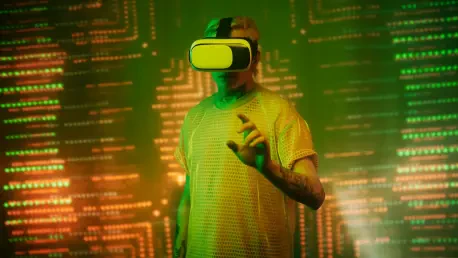In an era where workforce skills must evolve at lightning speed to keep pace with technological advancements, traditional corporate training often falls short, leaving employees underprepared and disengaged. Enter Lenovo, a titan in global technology, and VR Vision, a Canadian innovator in immersive learning, whose groundbreaking partnership is reshaping how industries approach employee development. By harnessing the power of artificial intelligence (AI) and virtual reality (VR), this collaboration moves beyond outdated, one-size-fits-all training models to deliver personalized, data-driven experiences that adapt to individual needs. Spanning sectors like manufacturing, automotive, and energy, their solutions promise not only to enhance engagement but also to provide measurable outcomes that redefine efficiency. This dynamic approach addresses critical gaps in conventional methods, offering a glimpse into the future of enterprise learning where technology and human potential align seamlessly for transformative results.
Tailoring the Learning Experience
The cornerstone of this innovative alliance lies in its commitment to personalized training, a sharp departure from the rigid frameworks that have long dominated corporate education. VR Vision’s Vision Portal platform plays a pivotal role by capturing real-time data on user performance during VR sessions. This system dynamically adjusts content—whether by altering difficulty, offering specific feedback, or accelerating modules for quicker learners—ensuring that each employee receives a customized experience. Such adaptability mirrors the guidance of a dedicated mentor, embedded within the technology itself, catering to diverse learning paces and styles. This focus on individualization maximizes both engagement and knowledge retention, addressing a fundamental flaw in standardized programs that often leave participants struggling to keep up or unchallenged by repetitive content.
Moreover, personalization extends beyond mere content adjustment to foster a deeper connection with the material being taught. By analyzing how each learner interacts with simulations, the platform identifies strengths and weaknesses, tailoring scenarios to target areas needing improvement. For instance, a factory worker might face increasingly complex machinery tasks as mastery is demonstrated, while a novice receives step-by-step guidance until confidence is built. This nuanced approach ensures that training is not just a checkbox exercise but a meaningful journey toward skill mastery. The result is a workforce better equipped to handle real-world challenges, with learning experiences that resonate on a personal level and drive long-term retention of critical skills.
Merging AI with Immersive Technology
At the heart of this transformative effort is the seamless integration of AI with VR, creating training environments that are far more than static digital spaces. AI acts as the intelligent core, enabling simulations to respond dynamically to user actions, replicating real-world conditions with striking accuracy. Employees can engage in complex tasks—such as troubleshooting equipment or navigating high-risk scenarios—in a safe, controlled setting where mistakes become learning opportunities rather than costly errors. This responsive design marks a significant evolution in extended reality (XR) applications, shifting from passive observation to active, practical engagement that prepares individuals for the unpredictability of their roles.
This technological synergy also enhances the realism and applicability of training by constantly adapting to user inputs, ensuring that no two sessions are identical. For example, a technician practicing repairs in a virtual environment might encounter unexpected variables, like equipment malfunctions or time constraints, introduced by AI to test problem-solving under pressure. Such immersive experiences bridge the gap between theoretical knowledge and on-the-job performance, fostering muscle memory and decision-making skills in ways traditional methods cannot match. The outcome is a more confident and capable workforce, ready to tackle challenges with a level of preparedness that static training could never achieve, setting a new standard for enterprise learning.
Expanding Reach with Global Scalability
A defining strength of this partnership is its ability to deliver immersive training on a global scale without sacrificing quality or security. Lenovo’s deep expertise in hardware and enterprise solutions, combined with VR Vision’s cutting-edge software, creates a robust framework for deploying VR training across diverse regions and industries. This scalability ensures that companies can maintain consistency in training standards, whether for a small team or a multinational workforce. The technology’s design prioritizes secure data handling and reliable performance, addressing logistical challenges that often hinder widespread adoption of advanced training tools in large organizations.
Equally impressive is the emphasis on accessibility, which breaks down barriers that have historically limited global training initiatives. AI-assisted multilingual translation stands out as a key feature, allowing employees from different linguistic backgrounds to engage with the same content in their native languages. This capability fosters inclusivity, ensuring that a diverse workforce can collaborate effectively, regardless of geographic or cultural differences. By removing language as an obstacle, the platform enables seamless knowledge sharing and uniform skill development across borders, empowering companies to build cohesive, well-trained teams on an international stage.
Demonstrating Tangible Results
The real-world impact of this technology speaks volumes about its potential to revolutionize training practices across industries. A compelling example is the deployment at Toyota Material Handling, where VR training has been rolled out to over 300 dealerships worldwide. With more than 10,000 employees trained using customized software and XR headsets, the results are striking: annual savings exceeding $1.5 million, accelerated onboarding processes, and consistent performance improvements across the board. This case study underscores how Lenovo’s enterprise infrastructure, paired with AI-driven learning tools, translates into significant cost efficiencies and operational enhancements.
Beyond financial benefits, the success at Toyota Material Handling highlights the broader value of immersive training in standardizing quality and speed of learning. Employees across various locations achieve uniform competency levels, reducing discrepancies that often arise from inconsistent training methods. This consistency proves invaluable in industries where precision and reliability are paramount, ensuring that every worker, regardless of where they are based, meets the same high standards. Such outcomes validate the partnership’s approach, demonstrating that technology-driven training can deliver measurable returns while enhancing workforce readiness for complex, real-world demands.
Innovating Content Creation for the Future
Looking to the horizon, the integration of generative AI offers a tantalizing prospect for making immersive training even more accessible and efficient. Currently, crafting detailed VR simulations—such as virtual factory floors or specialized labs—requires weeks of meticulous 3D modeling and technical expertise. Generative AI could change this landscape dramatically by enabling companies to create sophisticated environments in mere hours, using simple text prompts or existing design files. This advancement stands to lower both the time and cost barriers, opening the door for businesses of varying sizes to adopt customized training solutions without needing extensive resources.
The implications of this innovation extend to democratizing access to high-quality training tools, particularly for smaller enterprises or those in emerging markets. By streamlining content creation, generative AI reduces dependency on specialized teams, allowing training programs to be developed and updated swiftly in response to evolving industry needs. This agility ensures that companies can stay ahead of technological shifts, equipping their workforce with relevant skills without delays. As this technology matures, it promises to redefine how quickly and affordably immersive learning can be implemented, paving the way for broader adoption across diverse sectors.
Leveraging Data for Ongoing Improvement
Another profound advantage of AI-powered VR training lies in the wealth of data it generates, offering organizations unprecedented insights into learning processes. Every user interaction—from task completion times to accuracy rates—becomes a valuable data point that can be analyzed to uncover patterns and pinpoint areas for enhancement. This continuous feedback loop transforms training into an iterative journey, where programs are refined based on real performance metrics. In high-stakes fields like aviation or energy, where safety and precision are critical, such data-driven adjustments can significantly elevate outcomes by addressing specific challenges.
This analytical approach also empowers companies to tailor future training initiatives with pinpoint accuracy, focusing resources on identified weaknesses or emerging needs. For instance, if data reveals recurring errors in a particular task, simulations can be adapted to provide additional practice or alternative teaching methods for that skill. The result is a training ecosystem that evolves alongside the workforce, ensuring relevance and effectiveness over time. By harnessing these insights, enterprises can not only improve individual performance but also enhance overall operational efficiency, positioning themselves at the forefront of industry standards.
Reflecting on a Transformative Shift
Looking back, the collaboration between Lenovo and VR Vision marked a pivotal moment in the evolution of workforce training, setting a benchmark for how technology could elevate learning. Their integration of AI and VR crafted a framework that adapted to individual learners, scaled globally, and delivered concrete results, as evidenced by deployments like Toyota Material Handling. This partnership demonstrated that immersive, data-driven solutions were not just futuristic ideals but practical tools that reshaped employee development. As industries continue to grapple with rapid change, the next steps involve broader adoption of these technologies, with a focus on refining generative AI for faster content creation and leveraging data analytics to anticipate future skill gaps. Enterprises are encouraged to explore how such innovations can align with their unique needs, ensuring that training remains a strategic asset in maintaining competitiveness and fostering a resilient, skilled workforce.









